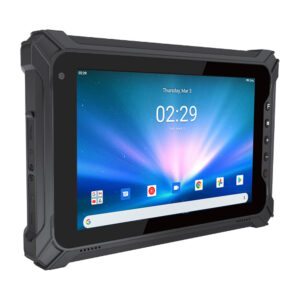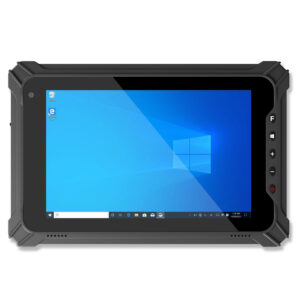Until recently, rugged devices were only offered by a small number of specialized manufacturers and were extremely expensive relative to retail tablets. Today, high-performance rugged devices are mainstream and affordable, changing the game for enterprises by making it affordable to equip employees working in the field. With the option to turn your field device into your laptop while charging by adding a docking station and keyboard, the 2-in-1 rugged tablet becomes the more affordable office tool.
In industries such as field service, construction, health care, manufacturing, and logistics, the purchasing decision has to include rough handling, the potential for drops and shocks, and working environments such as wet weather, dirt, and extreme temperatures. Other industries like food & beverage, hospitality, and golf clubs have unique challenges to consider such as dealing with grease, corrosive fluids, vibrations, and hot & cold temperature transitions.
At first glance, the difference in price between a consumer off-the-shelf device and a rugged device may appear substantial. It might tempt the uninformed to simply replace a consumer device with a new one when they inevitably break. However, with a little more research, many businesses are finding that the investment in rugged tablets actually saves a significant amount of money. The reason consumer devices are so susceptible to breakage and failure is that they require frequent – not one-time – replacement. That constant churn of devices causes work stoppages and lost productivity which is far more costly than simply replacing a device. Consumer devices also have a shorter useful life because manufacturers of these retail devices, want to keep replacement cycles short and continually release new features (most of which have no added value for enterprise use). Rugged tablets, on the other hand, are factory-supported for a useful life that is twice that of most consumer products.

Before You Purchase Consider the Total Cost of Ownership
When you consider important consumer purchases such as buying a car, most people not only look at the sticker price but consider reliability, repair costs, safety and longevity. All those elements contribute to the Total Cost of Ownership (TCO). So, it only makes sense that when it comes to choosing a vital piece of business equipment, such as a mobile tablet, the same standards should apply. Purchasing in larger quantities allows a company to order custom rugged tablets to better address the complex challenges of their specific industry or business.
When medium to large businesses purchase tablets in bulk or in high volumes, it can further increase their ROI.
Consumer Grade vs. Rugged: Hardware Costs
A more mobile workforce means businesses need to provide equipment that can withstand frequent vibrations, extreme temperatures, moisture, dust, and hazardous situations. For this reason, consumer tablets, that might have initially looked attractive, will in the “real world” fall short of meeting minimum standards. Studies have shown that not only do consumer devices fail up to four times more often than rugged devices, but each failure results in longer periods of lost productivity and more IT support time to resolve.

Software – The Hard Reality
Rugged computers, such as Minno Tablets, aren’t only robust and purpose-driven when it comes to case design and components, but they are also built with operating systems and applications that can be easily managed, upgraded, and used by employees in any workplace setting. Some off-the-shelf tablet PCs may offer users software that’s familiar, but these apps tend to be better suited for consumer use, and less optimized for business purposes. By customizing your rugged tablet with business-specific applications, you can drive up productivity and efficiency.
Choosing the right OS is also key for versatility and reduction of project risk. Most rugged tablet producers and business-related software and application vendors build their tools to be compatible with Windows or Android. Other consumer-focused business-related operating systems can create project roadblocks when crucial applications don’t integrate. Non-compatibility issues waste time, and cost money to resolve, as developers are forced to retool essential applications.
It’s important for the operating system to be as robust as possible to support your business software. Currently, there are few consumer tablets with the ability to operate as fast and effectively as their rugged counterparts.

Add-Ons – Added Cost and Problems
An important consideration is whether to accessorize a tablet with add-ons or to choose a completely integrated solution that offers the capabilities you need as standard features. Most mobile devices have add-on capabilities. Some industries require multiple add-ons such as a barcode scanner or card reader. The downside of add-ons is that they are separate hardware components. The more add-ons needed, the higher the cost and more potential for problems. It is commonly understood that failure rates are higher for peripherals added to consumer tablets, than ruggedized mobile computers with components built-in. Bolting on peripherals can increase the risk of downtime, and in companies with many employees, managing tablet PCs, add-ons, and multiple ports and connectors can become a logistical and inventory headache.
One of the most significant benefits of rugged tablet computers like Minno, is that they have been designed with business-specific functionality. Integrated components and accessories seamlessly work together. Rugged computers often feature built-in barcode and RFID scanners, GPS, and high-resolution cameras. One well thought out, integrated tool to get the job done.
While the tangible costs are readily apparent (cost of the device, software, installation, training, etc.) the often hidden intangible costs are frequently far more important in the long run.
Immediate Costs vs Long Term Costs
Businesses of all sizes are concerned with their return on investment (ROI) when it comes to making mobile computing purchase decisions. Companies simply cannot invest in tablet PCs without understanding both short-term and long-term costs. Often times Total Cost of Ownership analyses neglects to look carefully at the soft costs and variables that can impact the productivity of their employees.
A recent study produced by VDC Research (a B2B tech consulting firm) reported that over 50% of the total cost of using an enterprise mobile computing device can be traced to lost worker productivity due to device failure. The same report also noted that the average annual TCO of rugged tablets is $3,423 compared to a TCO for a non-rugged device of $7,330. Their analysis takes into consideration not only the cost of the equipment but the equally important long-term costs generated by lost productivity when employees have to deal with equipment failure. It is estimated that employees lose between 76-101 minutes of productivity when mobile devices fail. Multiply that by repeated failures over the life of the device and you can see how that would represent a significant cost.
Failure Costs
Independent research has shown that if a non-rugged mobile computer spends more than 40% of its time outside of the workplace, or in taxing environments such as a warehouse or manufacturing floor, the annual failure rate can exceed more than 30% per device. Companies still using consumer-grade tablets run the risk of having one-third of their computers in the field needing to be repaired or replaced entirely. By comparison, rugged tablets have much lower failure rates, less than 4% a year. The cost of failure rates also tends to rise yearly as part costs and repair labor costs are estimated to rise as much as 30% over the next three years. Thus, the reduction of computer failures is a key consideration for TCO.
Other TCO Considerations at a Glance:
- TCO falls with each level of ruggedness, so the more rugged the computer, the lower the TCO over time. The difference can amount to more than $3,900 per device, per year.
- On average the TCO for rugged computers over three years is 15% lower than that of non-rugged computers. That represents hundreds of dollars of savings per unit.
- The average life expectancy of a consumer tablet in a mobile or fieldwork environment is around 90-180 days. Business-grade off-the-shelf tablets perform a bit better but still are not designed for in-field use. Rugged tablets designed and built for use in challenging environments can be going strong four to six years later.
- A recent mobile industry study showed that consumers have become more impatient. Overall 38% of survey respondents said they were less patient than they were five years ago and 45% of millennials said the same thing. So delays caused by equipment failure can have a significant effect on customer satisfaction, which can directly impact an organization’s bottom line.

Minno stands for Mobile Innovation and Value
Minno is a privately held manufacturer of full-featured, high-performance rugged tablets (Android and Windows) and custom-designed or branded tablets for industry, education, and governments sold B2B in volume at prices well below retail brands. Minno rugged tablets are designed for high performance, durability, reliability, and versatility. Our tablets will change how your business operates and deliver value to customers by delivering productivity, efficiency, and business agility.




